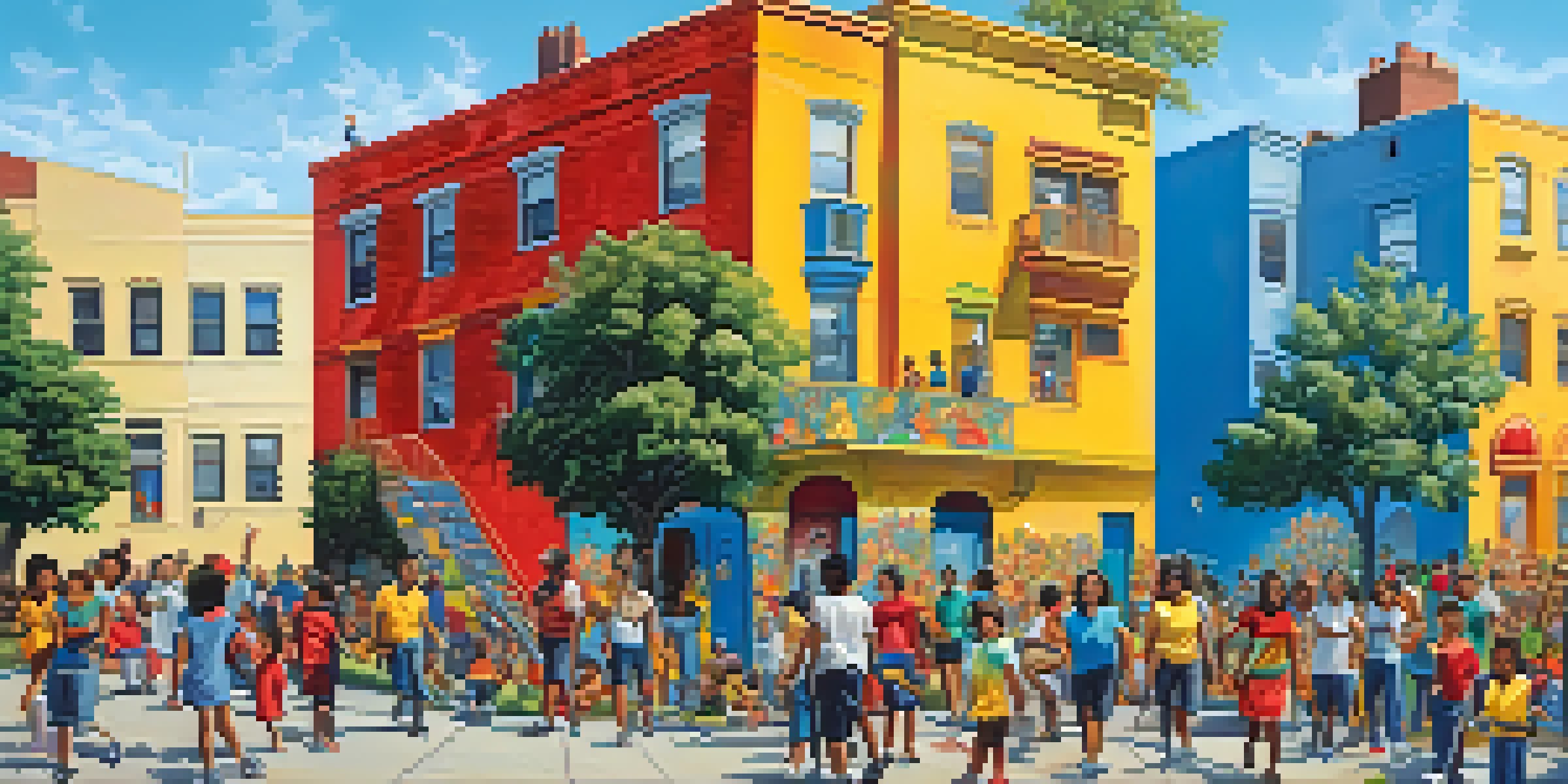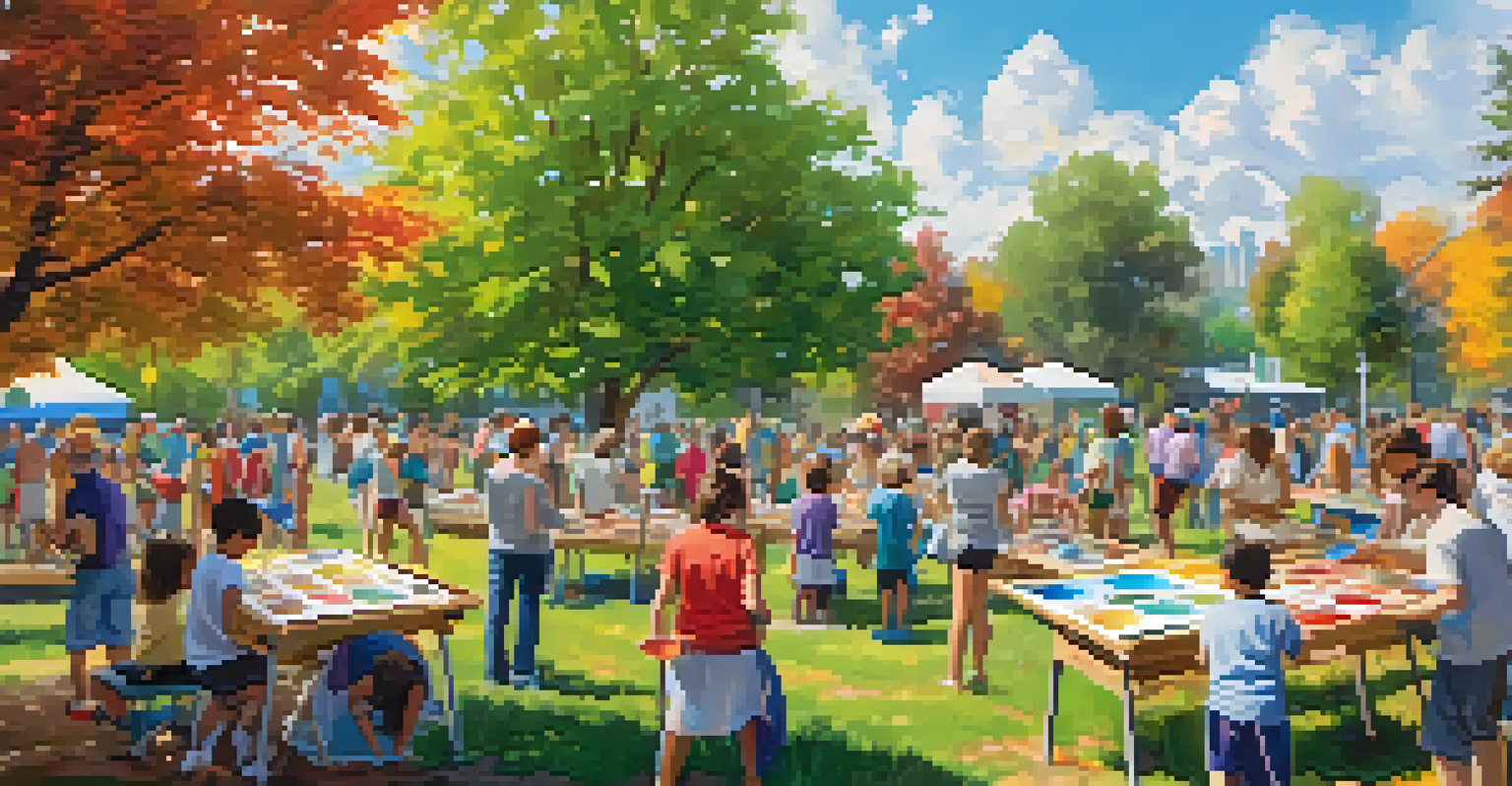Public Art Funding: Sources and Sustainability Strategies

Understanding Public Art and Its Importance
Public art encompasses various forms of creative expression that exist in communal spaces, enhancing our everyday environments. Think of murals, sculptures, and interactive installations that invite community engagement and reflection. These artworks not only beautify neighborhoods but also foster a sense of identity and pride among residents.
Public art is a way to bring communities together and create a dialogue about our shared experiences.
The importance of public art lies in its ability to spark conversations and connect diverse communities. It serves as a platform for artists to voice social issues, cultural histories, and collective memories. Moreover, public art can boost local economies by attracting tourists and increasing foot traffic in an area.
In recognizing these benefits, we can better appreciate the need for sustainable funding sources that ensure public art projects thrive. As cities grow and evolve, maintaining the vibrancy of public art becomes essential for fostering community spirit and cultural dialogue.
Major Sources of Public Art Funding
Public art projects can be funded through various streams, including government grants, private donations, and corporate sponsorships. Local, state, and federal governments often allocate funds specifically for public art initiatives, reflecting a commitment to enhancing community spaces. These grants can vary in size and requirements, so it’s essential for artists and organizations to stay informed about available opportunities.

Additionally, private donations play a crucial role in funding public art. Individuals who are passionate about the arts may contribute financially, while local businesses can also get involved, creating a partnership that benefits both parties. These collaborations can lead to increased visibility for both the artist and the business, creating a win-win situation.
Public Art Enhances Community Identity
Public art plays a crucial role in beautifying neighborhoods and fostering a sense of pride among residents.
Corporate sponsorships further expand the funding landscape. Companies often seek to enhance their brand image by supporting arts initiatives, allowing them to demonstrate social responsibility. By tapping into these resources, artists and organizations can secure the financial backing needed to bring their creative visions to life.
The Role of Nonprofits in Public Art Funding
Nonprofit organizations are vital players in the realm of public art funding. They often provide grants and resources specifically aimed at supporting artists and community-driven projects. These organizations can act as intermediaries, helping to connect artists with potential funders and ensuring that projects align with community needs.
Art can be a powerful catalyst for change, inspiring individuals to come together and recognize their shared humanity.
In many cases, nonprofits focus on specific themes or demographics, which can attract targeted funding. For instance, an organization dedicated to promoting environmental sustainability might fund a project that emphasizes eco-friendly art installations. This specialization not only helps secure resources but also aligns projects with broader social goals.
Moreover, nonprofits often organize events and initiatives that draw attention to public art, generating additional funding through ticket sales and donations. By partnering with these organizations, artists can leverage their extensive networks and expertise to enhance their chances of securing funding and achieving project success.
Crowdfunding: Empowering Community Support
Crowdfunding has emerged as a powerful tool for funding public art projects, allowing artists to tap into community enthusiasm. Platforms like Kickstarter and GoFundMe enable artists to present their ideas and seek financial backing directly from supporters. This approach not only raises funds but also fosters a sense of ownership among community members.
By engaging the public in the funding process, artists can create a deeper connection with their audience. Supporters often feel more invested in a project they helped fund, leading to greater community engagement. This model encourages collaboration and dialogue, making the artwork more meaningful and reflective of the community's values.
Diverse Funding Sources Essential
Public art projects rely on various funding streams, including government grants, private donations, and corporate sponsorships.
However, successful crowdfunding requires effective marketing and communication strategies. Artists need to clearly articulate their vision and demonstrate how their projects will benefit the community. By crafting compelling narratives and utilizing social media, artists can maximize their reach and increase the likelihood of achieving their funding goals.
Sustainability Strategies for Public Art Projects
Sustainability in public art goes beyond funding; it encompasses the longevity and relevance of the artwork itself. Artists and organizations should consider the materials and methods they use, opting for eco-friendly options that minimize environmental impact. This approach not only aligns with modern values but can also attract environmentally conscious funders.
Engaging the community throughout the creation process is another key strategy for sustainability. By involving local residents in the design and implementation phases, artists can ensure that the artwork resonates with its audience and meets their needs. This collaborative effort fosters a sense of pride and ownership, encouraging the community to care for and maintain the artwork.
Lastly, developing a maintenance plan for public art installations is essential for their long-term success. Regular upkeep ensures that the artwork remains in good condition and continues to inspire. By planning for maintenance from the outset, artists can enhance the sustainability of their projects, securing their place in the community for years to come.
The Impact of Public Art on Communities
The impact of public art on communities is profound and multifaceted. It can transform dull spaces into vibrant hubs of creativity, acting as a catalyst for social change. When people encounter art in public spaces, it often provokes thought, evokes emotions, and encourages discussions about important issues.
Public art projects can also play a significant role in revitalizing neighborhoods. By beautifying an area, they can attract new businesses and residents, ultimately leading to economic growth. This kind of transformation not only improves the aesthetics of a community but also contributes to a sense of safety and pride among its inhabitants.
Sustainability is Key for Longevity
Ensuring the sustainability of public art involves using eco-friendly materials, engaging the community, and developing maintenance plans.
Moreover, public art can strengthen community bonds by providing a shared experience for residents. Events such as art unveilings or community workshops foster connections among people, bridging gaps between diverse groups. In this way, public art serves as a vital tool for promoting inclusivity and belonging within a community.
Challenges in Public Art Funding and Sustainability
Despite the many benefits of public art, funding and sustainability remain significant challenges. Economic downturns can lead to reduced government budgets for art initiatives, making it difficult for projects to secure necessary funding. Additionally, the competition for grants and sponsorships can be intense, with many deserving projects vying for limited resources.
Moreover, public art projects often face scrutiny from community members regarding their relevance and appropriateness. Artists must navigate differing opinions and preferences, which can complicate the funding process. This highlights the importance of community engagement and communication in ensuring that projects resonate with the public.

Finally, as urban environments evolve, maintaining and preserving public art installations can become a challenge. Weather, vandalism, and changing community needs can all impact the longevity of an artwork. Artists and organizations must be proactive in addressing these issues to ensure that their projects remain relevant and impactful.
Future Directions for Public Art Funding
Looking ahead, public art funding is likely to evolve in response to changing societal values and technological advancements. Artists and organizations may increasingly leverage digital platforms for funding and engagement, reaching broader audiences through online campaigns. This shift could open new doors for collaboration and creativity.
Additionally, as communities become more aware of social and environmental issues, there may be a growing demand for public art that addresses these concerns. Artists who focus on themes of inclusivity, sustainability, and social justice may find more opportunities for funding and support. This trend will encourage the creation of art that reflects the values and aspirations of modern society.
Ultimately, the future of public art funding will depend on the ability of artists and organizations to adapt and innovate. By embracing new strategies and fostering community engagement, they can ensure that public art continues to thrive, enriching our communities for generations to come.